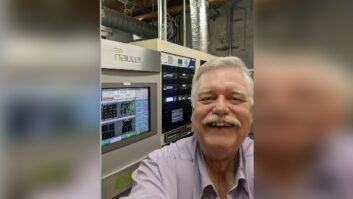TI Readies Second-Generation IBOC Chip; Analog, Digital Processing on Single Baseband
DALLAS Texas Instruments has its second-generation IBOC chipset ready for receiver manufacturers. TI and Ibiquity say this is the first chip with the analog and digital processing incorporated into a single baseband – reducing manufacturing costs.
The previous chip for HD Radios, released in August 2002, had analog and digital processing on separate chips. The digital portion was literally “bolted onto” the analog baseband, said TI spokesman John Gardner. One advantage of the new, integrated chip is the savings derived from eliminating a baseband, he said.
For use in automotive radios, the DRI250 chip integrates IBOC and intermediate frequency-sampled AM/FM, as well as audio processing and MP3 and Windows Media Audio CD support on the baseband.
Gardner said combining these capabilities in software on one chip saves manufacturing costs. For example, the sample cost per unit for the DRI200 introduced last year at this time was $50, while the sample price for the DRI250 is $30.
Improved range
The chip handles the IBOC modulation and decoding necessary to process Ibiquity’s AM and FM waveforms.
TI claims improved dynamic range for analog AM/FM in receivers using its software radio algorithms, including improved AM receiver behavior in the presence of second-adjacent hybrid (analog and digital) signals.
Samples of both chips are to be available in the fourth quarter for use in 2004 HD Radios.
Gardner said the software-programmable chips will allow for features to be incorporated in the future such as surround sound for FM and time buffering for the ability to “rewind” live radio.
TI said the benefit of upgradeable software was demonstrated in dramatic fashion when its first Ibiquity chip, the DRI200, accommodated Ibiquity’s recent switch from PAC to the new HDC codec.
Gardner said TI’s previous experience developing DSP chips for cell phones and Eureka-147 radios has enabled it to apply some of those technologies to terrestrial digital radio.
TI is an investor in Ibiquity. It predicts digital radios will replace analog radios in the United States by the year 2010.
A new companion analog front end complements the DRI250 baseband. TI’s new mixed — signal DRI8201 chip provides the IF analog — to-digital converter, digital down converter and control digital-to-analog converter needed in a complete digital radio design to process the audio. The DRI8201 uses an 80-MHz, 12-bit ADC to digitize the AM/FM intermediate frequency signal from the radio tuner.
TI claims performance improvement through oversampling done by the 12-bit ADC on the chip. Through software radio algorithms, such as adaptive stereo separation and adaptive audio bandwidth control, the DRI250 addresses specifications for audio signal-to-noise ratio, total harmonic distortion + noise and stereo separation and sensitivity.











